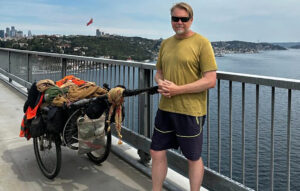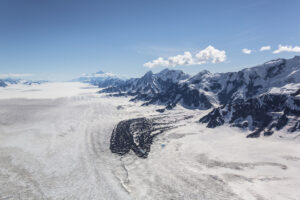Officially, marathon swimming is any open swim over 10km long where no wetsuits are allowed, just a normal swimsuit, goggles and a thin cap. One of the earliest known marathon swims was one of the classics: Captain Matthew Webb became the first person to swim the English Channel in 1875.
A few decades later, in 1926, Gertrude Ederle accomplished perhaps the most famous marathon swim in history: At just 19 years old, she became the first woman to swim the Channel and smashed the world record in the process.

Gertrude Ederle, the first woman to swim the English Channel.
Although women are slower than men at most sports, Ederle’s achievement hinted at things to come. Women, it turns out, excel at marathon swimming. Exercise researcher Beat Knechtle has studied gender differences in ultra-distance events (anything over six hours). This includes finishing times in running, swimming and cycling. Only in ultra-distance swimming do women achieve a similar or even superior performance to men.
Looking at 30 years of finishing times for the 46km Manhattan Island Marathon Swim, Knechtle noted that the fastest women were on average 12 to 14 percent quicker than the fastest men. Similarly, in 87 years of the 32km Catalina Channel swim, the fastest woman averaged 53 minutes quicker than the fastest man.

Diana Nyad broke the record for the 46km Manhattan Island swim in 1975, at age 28.
Steven Munatones, one of the world’s experts on open-water swimming, analyzed the results for about a dozen popular marathon swims. He came to a different conclusion than Knechtle. Munatones found that the fastest men beat the fastest women, but that the average woman was faster than the average man.
This difference in conclusions most likely comes from the fact that Knechtle studied smaller-scale events, which attract more amateur swimmers, whereas Munatone looked at prestige swims such as the English Channel, which draw everyone from fast pool swimmers to ex-Olympians.
Since 1926, when Ederle first broke the overall English Channel record, women have set the Channel speed record a few other times.
Elite men, however, still have the fastest times. Trent Grimsey of Australia currently holds the record for the roughly 30km crossing, at 6 hours and 55 minutes — a pace of about 1 minute, 12 seconds per 100m. The fastest woman has finished in 7 hours, 25 minutes. That’s a fairly typical gender gap over that distance for elite swimmers. Still, when you look at the Channel’s 135-year history, the average female time is 33 minutes faster than the average man’s.

Elite swimmer Petar Stoychev is one of just two men to cross the English Channel in under seven hours, while the fastest woman is less than half an hour behind.
Women have lower hemoglobin levels, smaller hearts and generally less power in their muscles, so they won’t be sprinting faster than men in the near future. But ultra-distance sports are different. Women might not always win, but they are closer than usual to men’s performances, and they are starting to catch up.
The reasons are not entirely clear. It could be that in recent years, more women have taken part in these events. Also, as distance increases, pure power matters less. Determination, a race plan and nutrition play a more important role, and none of these depend on gender. In swimming — compared to, say, running or cycling — technique also matters more. Brute strength takes you only so far, while minimizing drag and moving efficiently make a significant difference for amateurs.
Women also have a higher fat percentage of body fat than men, and are better at burning fat over long distances. Men, on the other hand, deplete their carbohydrate stores more quickly.
Knechtle observed that on average female ultra-distance swimmers had about 31 percent body fat, while men had about 20 percent. This higher percentage may improve buoyancy, he points out. More importantly, fat adds vital insulation in cold water, since unlike triathlons, marathon swimming does not allow wetsuits.
Lynne Cox is one of the best open-water swimmers the world has seen. In 1971, at age 14, she swam the 50km Catalina Channel in southern California. At ages 15 and 16, she set new record times for the English Channel. In time, she discovered that she was exceptionally good in cold water and she began to explore that medium. She has pushed the boundaries of the possible for decades.

A young Lynne Cox, age 14.
In 1987, she accomplished her most famous swim, a 4.3km crossing of the Bering Strait, with water temperature between 3° and 4°C. In 2002, Cox decided to test her limits even further by swimming in Antarctica, where the water is so cold that local fishing boats don’t even have life jackets. As one boat captain said, “It’s a waste of time. Within a minute, anyone would be dead.”
The water temperature was -1.7°C when Cox set off. Wearing only a swimsuit, she covered about two kilometres in 25 minutes. She is an absolute wonder, and her success in the cold has prompted both Navy SEALS and university researchers to study her, to better understand the body’s capabilities in cold water.
Cox has often noted that her fuller figure helped her cold-water swims. Her 36 percent body fat — which she herself refers to as “blubber” — shelters her vulnerable core from the cold “like an internal wetsuit,” she says. Furthermore, her body density is precisely that of sea water, giving her perfectly neutral buoyancy. She doesn’t have to work to stay afloat.
All of this does not mean she feels warm. She admits to being cold, but sheer mental strength keeps her going. “I feel the cold. I feel pain. I just can’t let it change what I’m trying to do,” she says.

Lynne Cox in the icy waters of Antarctica
Marathon swimming might just be one of the world’s most difficult sports, because of this element of cold. Here, women are not only holding their own against their male competition, but in many cases are waiting on shore watching the men finish behind them.






